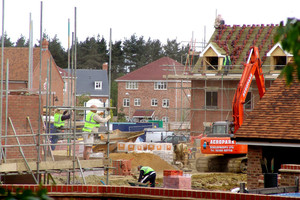 The Environmental Audit Committee is launching an inquiry into the sustainability of the built environment, to look at the best routes to net zero for our future building needs from low carbon materials through to policies to minimise the whole life carbon impact of new buildings, and closing 15 May.
The Environmental Audit Committee is launching an inquiry into the sustainability of the built environment, to look at the best routes to net zero for our future building needs from low carbon materials through to policies to minimise the whole life carbon impact of new buildings, and closing 15 May.
image: for illustration purposes only – Open Government Licence v3.0
… embodied carbon cost of the construction is not required by current policy…
… builders will no longer need a normal planning application to demolish…
UK Parliament writes:
The Government’s target of building 300,000 new homes per year means that a huge amount of construction is anticipated over the coming decade. Although the operating energy efficiency of a building is taken into account, the embodied carbon cost of the construction is not required by current policy to be assessed or controlled, other than on a voluntary basis.
A recent change to permitted development rights provides that “builders will no longer need a normal planning application to demolish and rebuild vacant and redundant residential and commercial buildings if they are rebuilt as homes”. provided that the building was constructed before 1990. While this is designed to stimulate housing delivery, there are questions about whether demolition and rebuilding is the most sustainable approach from a life-cycle carbon standpoint.
The Future Homes Standard will come into effect in England in 2025 and ensure that new homes are futureproofed with low-carbon heating systems and high levels of energy efficiency. Demand for cooling is also likely to increase in future and buildings which can cool themselves passively will reduce the demand on the grid. Setting clear guidelines for sustainable construction now will ensure that we do not lock in a high carbon approach to building new homes and other structures, making it harder to achieve the UK’s net zero target.
Where new building is necessary, the construction industry is well placed to establish a market for low-carbon building materials, but there is no incentive to move away from concrete and steel as the primary structural materials in new builds. Lower-carbon building can be achieved through a number of routes, from using low-carbon resources like wood and other natural materials, to ensuring that building design utilises the minimum amount of resources.
Green infrastructure can provide numerous benefits to complement the built environment such as cooling urban areas in heatwaves, creating networks of habitats, reducing run-off and flooding, providing job creation and improving people’s health and wellbeing.
Since the Grenfell Tower disaster in 2018 there have been restrictions placed on the use of wooden cladding on buildings which it has been argued has limited the development of alternative options like engineered wood, designed as a structural replacement for concrete. Natural insulation materials are also penalised within building regulations for the difficulty in calculating their effectiveness.
The Climate Change Committee’s 2019 Report, UK Housing Fit for the Future makes a number of recommendations to Government on sustainable building, including incentivising the increased use of wood in construction and developing policies to minimise the whole life carbon impact of new buildings. This inquiry aims to follow up on the progress of these recommendations.
The Committee is inviting written submissions on:
- To what extent have the Climate Change Committee’s recommendations on decarbonising the structural fabric of new homes been met?
- How can materials be employed to reduce the carbon impact of new buildings, including efficient heating and cooling, and which materials are most effective at reducing embodied carbon?
- What role can nature-based materials can play in achieving the Government’s net zero ambition?
- What role can the planning system, permitted development and building regulations play in delivering a sustainable built environment? How can these policies incentivise developers to use low carbon materials and sustainable design?
- What methods account for embodied carbon in buildings and how can this be consistently applied across the sector?
- Should the embodied carbon impact of alternative building materials take into account the carbon cost of manufacture and delivery to site, enabling customers to assess the relative impact of imported versus domestically sourced materials?
- How well is green infrastructure being incorporated into building design and developments to achieve climate resilience and other benefits?
- How should we take into account the use of materials to minimise carbon footprint, such as use of water harvesting from the roof, grey water circulation, porous surfaces for hardstanding, energy generation systems such as solar panels?
- How should re-use and refurbishment of buildings be balanced with new developments?
- What can the Government do to incentivise more repair, maintenance and retrofit of existing buildings?
Written evidence should be submitted through the Committee’s web portal by 15 May, 22:59. Respondents need not answer all the questions and evidence need not be limited to these questions. Submissions should be not more than 3,000 words but shorter submissions are welcomed and encouraged.
We encourage members of underrepresented groups to submit written evidence. We aim to have diverse panels of Select Committee witnesses and ask organisations to bear this in mind when we ask them to choose a representative. We are currently monitoring the diversity of our witnesses. It is recommended that all submitters familiarise themselves with the Guidance on giving evidence to a Select Committee of the House of Commons which outlines word count, format, document size, and content restrictions.

